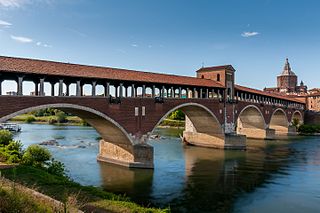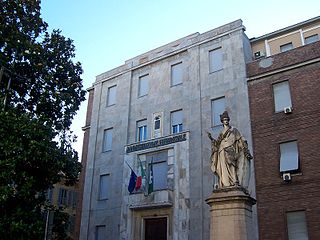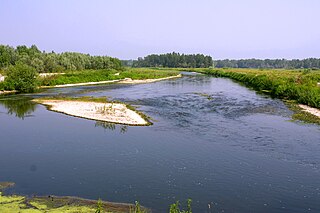
Lombardy is an administrative region of Italy that covers 23,844 km2 (9,206 sq mi); it is located in northern Italy and has a population of about 10 million people, constituting more than one-sixth of Italy's population. Lombardy is located between the Alps mountain range and tributaries of the river Po, and includes Milan, its capital, the largest metropolitan area in the country, and among the largest in the EU.

Pavia is a town and comune of south-western Lombardy, in Northern Italy, 35 kilometres south of Milan on the lower Ticino near its confluence with the Po. It has a population of c. 73,086.

Vigevano is a comune (municipality) in the province of Pavia, in the Italian region of Lombardy. A historic art town, it is also renowned for shoemaking and is one of the main centres of Lomellina, a rice-growing agricultural district. Vigevano received the honorary title of city with a decree of Duke Francis II Sforza on 2 February 1532. It is famed for its Renaissance Piazza Ducale in the centre of the town. It is also known for the Rassegna Litteraria di Vigevano, an annual cultural event celebrating literature and the arts, which honours two distinguished personalities from the world of culture every year with the National Prize and the International Career Prize.

Magenta is a town and comune in the Metropolitan City of Milan in Lombardy, northern Italy. It became notable as the site of the Battle of Magenta in 1859. The color magenta takes its name from the battle.

Unione Sportiva Triestina Calcio 1918, commonly referred to US Triestina or just Triestina, is an Italian football club based in Trieste, in the northern Friuli-Venezia Giulia region. Originally established in 1918, Triestina was one of the founding members of Serie A in 1929 and featured in Italian top flight until the late 1950s. Triestina spent the following decades in lower levels, and during that time the club was folded and re-established several times. As of the 2024–25 season it plays in Serie C, the third tier of Italian football.

The province of Pavia is a province in the Lombardy region of Italy. Its capital is Pavia. As of 2015, the province has a population of 548,722 inhabitants and an area of 2,968.64 square kilometres (1,146.20 sq mi); the town of Pavia has a population of 72,205.

F.C. Lumezzane, commonly known just as Lumezzane, is an Italian association football club based in Lumezzane, Lombardy. The club currently competes in Serie C, the third tier of Italian football.

Associazione Calcio Dilettantistica Legnano, commonly referred to as Legnano, is an Italian football club based in Legnano, Lombardy. Founded in 1913, Legnano played three seasons in Serie A and a total of eleven seasons in the top tier of the Italian football league system.
A.S.D. SolbiaSommese Calcio is an Italian association football club located in Somma Lombardo and also representing the town of Solbiate Arno, Lombardy. It currently plays in Eccellenza Lombardy/A.

Associazione Sportiva Dilettantistica AVC Vogherese 1919 is an Italian football club, based in the town Voghera, Lombardy. It plays at Voghera's Stadio Comunale Giovanni Parisi, with a capacity of 4,000 seats. The team colors are red and black, as is its nickname "Rossoneri".
Cava Manara is a comune (municipality) in the province of Pavia in the Italian region Lombardy, located about 35 km south of Milan and about 7 km southwest of Pavia, not far from the confluence of the Ticino and the Po rivers.

Cilavegna is a comune (municipality) in the Province of Pavia in the Italian region Lombardy, at about 45 km southwest of Milan and about 35 km northwest of Pavia. It has 5440 inhabitants.
Garlasco is a comune (municipality) in the Province of Pavia in the Italian region Lombardy, located about 35 kilometres (22 mi) southwest of Milan and about 20 kilometres (12 mi) west of Pavia. As of 31 December 2004, it had a population of 9,343 and an area of 39.0 square kilometres (15.1 sq mi).

Lomello is a comune (municipality) in the Province of Pavia in the Italian region Lombardy, located about 50 km southwest of Milan and about 30 km west of Pavia, on the right bank of the Agogna. It gives its name to the surrounding area, the Lomellina. Lomello borders the following municipalities: Ferrera Erbognone, Galliavola, Mede, Ottobiano, San Giorgio di Lomellina, Semiana, Velezzo Lomellina, Villa Biscossi.
Tromello is a comune (municipality) in the Province of Pavia in the Italian region Lombardy, located about 35 km southwest of Milan and about 25 km west of Pavia. As of 31 December 2004, it had a population of 3,561 and an area of 35.2 km2.

Zerbolò is a comune (municipality) in the Province of Pavia in the Italian region Lombardy, located about 30 km southwest of Milan and about 11 km west of Pavia.
Zinasco is a comune (municipality) in the Province of Pavia in the Italian region Lombardy, located about 40 km south of Milan and about 10 km southwest of Pavia in the Lomellina. It is formed by two villages, Zinasco Vecchio, known from the 12th century, and Zinasco Nuovo. It became part of the Savoy-Piedmont in 1713.
Francesco Sampietro was an Italian painter, mainly of sacred subjects.

The history of Cilavegna, an Italian municipality located in Lomellina, begins from the Iron Age, when those territories were inhabited by the people of Laevi. In the following centuries, moreover, there were many populations that occupied Lomellina and, for the specific territory of Cilavegna, the Roman one was the most significant one: in fact, it is attested that along a Roman road a nucleus called cella ad vineas was created, an encampment to refresh the marching troops. Another noteworthy period was from the end of the Early Middle Ages to the beginning of the Late Middle Ages, during which the settlement of Cilavinnis was first mentioned. Later, in feudal times, several families alternated in the possession of the locality: among all are mentioned the Palatine counts of Lomello, but above all the Atellani and the Taverna families, who played an important role in the town in modern times. Between the 16th and 19th centuries Cilavegna was conquered and occupied, for longer or shorter periods, by the French, Spanish and Austrians, until it was annexed to the Kingdom of Italy.

The Parco naturale lombardo della Valle del Ticino is a Nature reserve established on 9 January 1974. It was the first Italian regional park to be established and the first European river park. The park is located along the banks of the river Ticino, in Lombardy, in the provinces of Milan, Pavia and Varese, in an area of 91,410 hectares between Lake Maggiore and the Po. The park borders the Parco naturale della Valle del Ticino, located on the other side of the river in Piedmont, created in 1978. In 2022 the two Parks were included by UNESCO in the World Network of Biosphere Reserves.


















